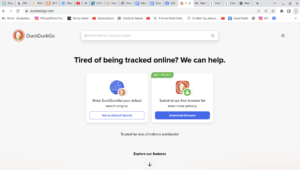In 2024, organisations face an ever-evolving landscape of browser threats, one of the most troubling being the Browser in the Browser (BitB) phishing attack. This sophisticated method challenges traditional notions of browser security, making it particularly difficult to detect and combat.
At its core, a BitB attack manipulates users by displaying a fraudulent browser window within their legitimate browsing session. This deceptive display tricks victims into entering sensitive information as they believe they are interacting with a legitimate website. The authenticity of what appears to be a familiar login page can easily lure even the most vigilant users into a trap.

Awareness is critical to protecting yourself from these attacks. Always verify URLs carefully and consider using multi-factor authentication wherever possible. Organisations should train employees to recognise signs of phishing attempts and encourage them to report suspicious activity immediately.
As the digital landscape continues to shift, staying informed about emerging threats like BitB attacks is essential for safeguarding personal and organisational data. Let us navigate this new terrain together, fortifying our defences against such insidious tactics.
Understanding Phishing
Before we delve into the intricacies of Business Email Compromise (BEC) attacks, it’s essential to grasp the fundamental concept of phishing. At its core, phishing is a deceptive cyber attack that relies on cloaked emails to trap unsuspecting victims.
Phishing emails often mimic legitimate correspondence, making them appear as if they originated from trusted entities—such as banks, service providers, or even colleagues within a company. The goal is cunningly simple yet effective: to convince the recipient that the message is something that Evolution into BitB.
As the cybersecurity landscape continues to evolve, so too do the tactics employed by cybercriminals. One of the newest and most insidious threats is the Browser in the Browser (BitB) attack, a deceptive variant of traditional phishing schemes.

In a BitB attack, victims are lured into a false sense of security. While they navigate what seems to be a legitimate website in their trusted browser, an embedded fake webpage cleverly mimics actual login pages. This illusion makes it challenging for users to discern reality from pretence.
Once they are hooked, unsuspecting individuals may inadvertently enter sensitive information like usernames and passwords into these counterfeit forms. Cybercriminals can then use this data for identity theft or illicit financial gain.

The sophistication behind BitB is alarming. Attackers exploit not only human psychology but also advancements in web technologies to create nearly indistinguishable replicas of genuine websites.
As our reliance on digital platforms grows, so does the imperative for both awareness and vigilance against these increasingly cunning mechanisms of deception. Educating users about potential pitfalls and promoting critical examination of online prompts is more vital than ever in safeguarding personal information against such evolving threats. Ital or urgent.
Once under this illusion, individuals may find themselves clicking on harmful links or downloading malicious attachments. These actions can lead to dire consequences, such as identity theft or system compromise.
Phishing preys on human psychology, exploiting trust and urgency. By creating a sense of immediacy or importance, attackers manipulate victims into taking hasty actions without scrutiny. Thus, understanding phishing becomes critical in safeguarding against BEC and other advanced cyber threats. Awareness and vigilance are critical in this ongoing digital battle for security.

How BitB Works
Picture this: you’re attempting to log into your favourite website, and suddenly, a new window appears. It catches your eye, demanding your credentials in a frank manner. At first glance, it seems legitimate.
You should realise that this isn’t a typical browser pop-up. Instead, it’s a meticulously crafted overlay made with HTML and CSS, designed to imitate the feel of a genuine browser interface.
From the URL bar displaying the correct site address to the reassuring SSL lock icon gleaming in the corner, everything looks authentic. The overlay’s dimensions match precisely what you’d expect from a standard login window, and the animations mimic those of your browser flawlessly.

However, beneath this convincing facade lies a sinister purpose. Every keystroke you make feeds directly into the hands of attackers waiting for their opportunity. Once you enter your information, it vanishes behind this curtain of deception—never destined for its intended destination. Instead of logging in safely, you’ve unwittingly handed over your credentials to someone lurking in the shadows.
The Threat to Browser Security
Browser security faces a formidable challenge from BitB attacks, which pose significant risks to users’ sensitive information. Unlike traditional phishing methods that often employ deceptive emails or malicious links, BitB attacks create a convincing fake browser window within the actual browser itself. This clever technique allows attackers to deceive unsuspecting users into entering their credentials or personal details.

One of the most alarming aspects of these attacks is their ability to evade established detection methods. Many security programs are designed to identify unusual web page behaviours or flag blocked URLs. However, because the fake window operates seamlessly within the legitimate browser interface, it slips past these protective measures undetected.
As users interact with what they believe is a genuine website, they remain blissfully unaware of the lurking danger. This manipulation not only exploits trust but also highlights vulnerabilities in current security frameworks that fail to recognise this sophisticated form of deception.
With each successful attack, the risk intensifies, underscoring an urgent need for improved strategies to safeguard against such threats. It serves as a stark reminder that even well-constructed defences can be breached when innovation meets deception on the internet’s front lines.
Ensuring Your Safety in the Digital Realm
In today’s increasingly complex digital landscape, safeguarding oneself against Browser in Browser (BitB) attacks demands not only vigilance but also a proactive approach to online security. These deceptive tactics can catch even the most cautious users off guard if they’re not adequately prepared. To help you navigate this challenge, here are some essential strategies to enhance your online safety.
First and foremost, it is crucial to verify the authenticity of URLs. Before you input any sensitive information—be it passwords, credit card numbers, or personal details—take a moment to scrutinise the URL displayed in your browser’s address bar. Unlike conventional phishing scams where misleading links may redirect users elsewhere, BitB attacks cleverly maintain an unaltered address bar while presenting a fraudulent overlay. This means that even if everything seems legitimate at first glance, one must remain vigilant and double-check that what appears on screen indeed corresponds with what is expected.

Next, look for indicators of legitimacy when browsing online. Always ensure that you are visiting a site with the correct URL and a secure HTTPS connection—these elements are fundamental markers of trustworthiness. However, it’s essential to keep in mind that BitB attacks can manipulate visual cues; thus, exercising extra caution is paramount.

Another effective measure is enabling two-factor authentication (2FA) whenever possible on your accounts. This additional layer of security significantly complicates unauthorised access attempts by requiring not just your password but also another verification step—such as a code sent to your mobile device or email—thus bolstering your defences against potential intruders.
Furthermore, consider investing in specialised browser security solutions like ConcealBrowse. These advanced tools are specifically engineered to detect and neutralise BitB attacks through sophisticated algorithms and real-time monitoring capabilities. They work tirelessly behind the scenes to identify fraudulent overlays and phishing attempts before they can compromise your sensitive information. By incorporating such resources into your online practices, you create an added barrier between yourself and cybercriminals who seek to exploit vulnerabilities.
The prevalence of Browser in the Browser phishing schemes serves as a stark reminder of why maintaining vigilance online is more critical than ever before. As cyber threats continue to evolve and adapt over time, our defensive strategies must similarly progress to match these emerging challenges. By equipping ourselves with knowledge about how BitB attacks operate and implementing proactive measures for protecting our data, we position ourselves more effectively against this shifting landscape of cyber dangers.

In conclusion, staying safe online requires diligence and an informed mindset regarding potential threats like BitB attacks. With careful attention paid to URL authenticity, awareness of legitimate site indicators, robust two-factor authentication practices, and investment in reliable security solutions—we can fortify our defences against those who would seek unauthorised access to our personal information. Embracing these steps ensures we remain one step ahead in safeguarding our digital lives from ever-present risks.

Maxthon’s Approach to Combating Phishing
In the ever-evolving landscape of online threats, Maxthon has implemented a robust suite of features designed to protect users from phishing attacks. Central to its strategy is an integrated anti-phishing technology that operates seamlessly within the browser. This system works tirelessly in the background, identifying and blocking access to known phishing sites, thereby providing real-time protection for your sensitive data.

As you browse the internet, Maxthon employs a rigorous URL verification process. Each time you attempt to visit a website, it cross-references the URL with an extensive database of verified sites. Should it detect any indication of a phishing attempt lurking behind that link, Maxthon will promptly alert you before you proceed any further.
To enhance your online experience while ensuring safety, Maxthon includes a smart browsing mode. This feature goes beyond essential protection by scrutinising web pages for suspicious links and potentially harmful content. By doing so, it adds another layer of security that helps users navigate the web with greater confidence.
In instances where users inadvertently stumble upon a phishing site, Maxthon takes immediate action by displaying an alert message. This warning highlights the risks associated with such sites and advises users to exit without delay—keeping them informed and aware at all times.
Recognising that new threats emerge regularly, Maxthon prioritises regular updates to its security protocols and anti-phishing databases. These frequent enhancements ensure that users are equipped with cutting-edge protective measures against cybercriminals’ latest tactics.
Moreover, Maxthon believes in empowering its user base through education about common phishing strategies. The browser provides in-browser prompts and informative articles aimed at increasing users’ awareness so they can independently identify potential threats as they navigate online spaces.
Safety remains paramount when downloading during browsing sessions; thus, files are meticulously scanned for malware or other harmful elements associated with phishing attacks before they reach your device, adding yet another protective measure against potential dangers.
For those who prefer more control over their online interactions, Maxthon offers customisable privacy settings. Users can tailor these settings according to their comfort levels when engaging with unfamiliar websites—a proactive approach that significantly reduces exposure to risk.
Additionally, community involvement plays a crucial role in enhancing security measures within Maxthon’s ecosystem. Users can report suspected phishing websites directly through the browser interface. This feedback loop fosters a collective effort to improve safety protocols and promote vigilance against emerging threats.
By embracing these comprehensive guidelines provided by Maxthon—ranging from real-time alerts and proactive education to community reporting—you can significantly bolster your defences against phishing attempts while enjoying a safer browsing experience overall.
